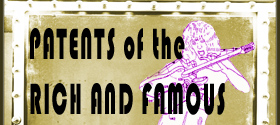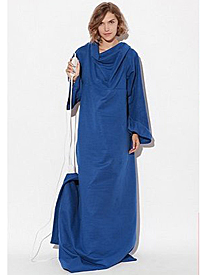Celebrity Invention: Zeppo Marx's Heart Rate Monitor and Heating Pad
 Some celebrities aren't just pretty faces. A few of them are also touched with that Yankee prowess for tinkering and invention. In this weekly series, we introduce you to the Patents of the Rich and Famous. And maybe you learn a little bit about how patent literature works along the way.
Some celebrities aren't just pretty faces. A few of them are also touched with that Yankee prowess for tinkering and invention. In this weekly series, we introduce you to the Patents of the Rich and Famous. And maybe you learn a little bit about how patent literature works along the way.Inventor: The (lesser known) Marx Brothers: Gummo and Zeppo. Two week's ago we looked at Gummo's contribution, this week: Zeppo.
Known For: Zeppo and Gummo were the handymen of the family.
Unlike their siblings, these younger brothers didn't really make it big in the vaudeville world. They got about as far as the picking-the-quirky-nickname part, and then dropped out of the act. Gummo (aka Milton) was part of the original Marx performance, appearing with Groucho in an act called "The Three Nightingales." But then, World War I came along, Gummo got drafted and left acting behind. After the war, he took the logical turn into the dress-making business.
Like Gummo, Zeppo (aka Herbert Manfred) started out acting, appearing in the early films, but left the family business to operate a parts manufacturing company known as Marman Products Co.
Perhaps intimidated by their older brothers' slapstick celebrity, Zeppo and Gummo aimed for fortune, not fame, by inventing useful, quotidian items. Combined, Gummo and Zeppo hold four U.S. patents.
Take that, Groucho, Chico and Harpo.
Invented Apparatuses #1 and #2: "Cardiac pulse rate monitor" and "method and watch mechanism for actuation by a cardiac pulse."
These two patents were filed within months of each other and used together.
Clearly, Zeppo was the fashionista of the clan. That is one hip watch.
And, not only does it look good, it also advises its wearer of an irregular heartbeat using an electric-powered magnet, which regulates pulse.
The unit is provided with an electric motor that is operated by the power of a small electric cell in a circuit that is intermittently closed by a pulse-actuated switch and which rotates a permanent magnet. The latter is enclosed in a housing that is held in a position corresponding to normal by a hairspring, said housing, under drag of the magnetic field of the magnet, being moved rotationally in the direction of magnet rotation, when the pulse rate is above normal, due to a more continuous energizing of the motor by the pulse, and said housing, under bias of the hairspring, being moved rotationally counter to said magnetic drag when the pulse rate is subnormal. A color-coded telltale advises of lesser pulse-rate variations in either direction. An audible alarm is provided to warn of excessively high or abnormally low changes of the pulse rate.
The electric cell powers a magnet that corresponds with the wearer's "normal" heart rate. If the pulse changes to an excessively low or high rate, the magnet detects this change, triggering an "audible alarm."
Rationale Behind Invention: For people with heart issues, knowing when something is off in the cardiac department is probably a good idea. Smart thinking.
Monitoring of the rate, amplitude and/or regularity of the pulse of a person with a cardiac impairment is desirable at all times, but is especially important under circumstances during which the pulse rate, amplitude and/or regularity may be affected drastically as, for instance, during periods of excessive emotion and athletic or other physical activities.
One important purpose of the invention is to provide means to give notice of a change in the pulse in either direction from a norm, and to do this even during short periods of time, so that the person affected may take steps to ameliorate the conditions or cause of such a change, without having to resort to material changes in physical or mental activities.
Off Label Uses: I'm thinking some sly Don Juan will use this watch to make passes on ladies. "What's that sound?" "Oh, this is embarrassing. My heart rate monitor is saying that my heart's going wild...."
Invented Apparatus #2: "Vapor delivery pad for distributing of moist heat."
Zeppo Marx invented the heating pad:
To this end, the invention contemplates the use of apparatus including a steam generator having means to regulate the delivery of heated vapor therefrom, a vapor delivery pad adapted to distribute the hot water vapors coming from the generator to a selected area of the patients body while the patient is lying directly upon the pad, and a connection between the generator and the pad for carrying the hot vapors from the generator to the pad.
 Rationale Behind Invention: According to his patent application, before Zeppo's innovation, the practice of heating a patient's body was a messy one. "The commonly accepted method in general used today is to apply, to the body of a patient, usually in a reclining position on a cot or hospital bed, towels that have been saturated in hot water and partially wrung out," he wrote. "This practice requires the frequent changing of the towels as the heat of the residual moisture therein is dissipated."
Rationale Behind Invention: According to his patent application, before Zeppo's innovation, the practice of heating a patient's body was a messy one. "The commonly accepted method in general used today is to apply, to the body of a patient, usually in a reclining position on a cot or hospital bed, towels that have been saturated in hot water and partially wrung out," he wrote. "This practice requires the frequent changing of the towels as the heat of the residual moisture therein is dissipated."Off Label Uses: While females claim to have co-opted the heating pad invention for "that time of the month," really, we just put it underneath our Snuggies, using it to heat our chilly frames. That might change, though, with the recent introduction of the Coz-E: an electric Snuggie.
Future Directions: The workout industry has already adapted the heart rate monitor for exercising. Take the next step. Integrate the heart rate monitor with the heating pad, creating a warm and efficient outdoor workout suit that exercisers can use in cold climates and during cold seasons.

